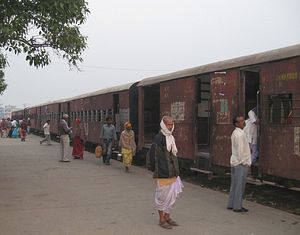The race is on between two old geopolitical rivals in Nepal to bring a railway to Kathmandu. According to the new Nepali budget, work on joining Kathmandu with Raxaul (on the Indian border) and with Keyrung (on the Chinese border) will start in the next two years. This pair of projects is part of the communist government’s bid to turn Nepal into a “vibrant economic bridge” between India and China. It would indeed be wonderful if Nepalis could tomorrow hop on a train in Kathmandu and get off in New Delhi or Beijing. Yet that dream is a long way from being realized.
Let’s start with China. In 2008 it was announced that the Qinghai-Tibet railway would be extended right up to Keyrung on the border with Nepal. Why not extend the line all the way to Kathmandu? asked Nepal. China agreed, in principle. There was even a pre-feasibility study of the 72-kilometer line, which found that a proper feasibility study would cost around 35 billion Nepali rupees ($314 million). China wanted Nepal to foot most of the bill; Nepal would like China to do it pro bono.
The same calculus is at work with the estimated total project cost of 275 Nepali trillion rupees. As the railway will have to pass through some of the toughest terrain in the world, the project will be both costly and complicated. For instance, the China-funded pre-feasibility study found that nearly the whole track would consist of tunnels and bridges. The underground tunnels underneath the Himalayas alone would span over 40-50 km.
Some Nepali engineers reckon the job is technically infeasible; others think there is a way out, if Nepal is ready to spend freely. China has refused to do most of the work on grants, as Nepal wants it to. But if Nepal builds the rail line with Chinese loans, people are asking, will the final cost be worth it?
India already helps Nepal run the 25-km Janakpur-Jainagar rail on the Indian border. But after the news of the cross-border Sino-Nepal railway started doing the rounds, the Indians came up with a separate proposal on the Raxaul-Kathmandu railway. A feasibility study has already been completed (although the estimated cost is yet to be worked out). One thing is for sure: this railway, passing mostly through flat lands, will be a lot cheaper to build than the high-altitude rail linking Kathmandu with Tibet.
But there is a curious twist. While India wants to extend the railway to Kathmandu on a “broad gauge,” Nepal says it will allow only the narrower “standard gauge,” which the Chinese use, for all cross-border links, including with India. The Indians have not reacted well to this. Nepal says it picked standard gauge not because it is popular in China but because it is the norm in the rest of the world. It is also comparably cheaper.
Nepal may feel it has nothing to lose even if India builds the Raxaul-Kathmandu link using broad gauge, as having two separate gauges will give Nepal more leverage over the operation of any future China-Nepal-India railway. Otherwise Nepal could have little say over the China-India trains that will zoom through its territory. (The goal is to make trains stop in Nepal, to switch tracks if nothing else.) But first, a more basic question: should the proposed railways with India and China be built at all?
There are already all-weather roads between Kathmandu and India. Upgrading and expanding them will be cheaper and more in keeping with Nepal’s seismically active topography. Likewise, although having all-weather roads between Nepal and China via Tibet will be tougher, the estimated costs for such roads are much lower than the price tag for a transborder railway with Tibet. But having agreed with both India and China to bring their railways, things may already be out of Nepal’s hands.
If the Indian railway comes to Kathmandu — and at least on paper, it is likely to be completed first because of the easy terrains — the Chinese may feel compelled to finish their own leg to the Nepali capital, even at great cost. This linking of Nepal with India and China will help with Sino-India trade, no doubt. But the main reason these railways may be built at all will be geostrategic.
Beijing has not looked kindly on the new American Indo-Pacific Strategy and India’s central role in it. Nor does it approve of the U.S. characterization of Nepal as a “pivotal” state in this strategy. Recently, the American and Chinese ambassadors in Kathmandu even got into back-and-forth over the alleged “debt trap” stemming from the proposed Chinese rail link to Nepal.
Analysts in Kathmandu expect a more muscular neighborhood policy in Narendra Modi’s second term as Indian prime minister. The fear is that as a part of the Indo-Pacific Strategy, India and the United States will work in tandem to limit China’s role in Nepal — and China will be forced to react.
But no one expects a railway from either India or China to come chugging into Kathmandu, or to any of Nepal’s other major cities, soon. India is notorious in Nepal for not finishing its projects on time. China is still unsure about the funding modality. Moreover, the new word from Beijing is that the 2020 deadline to extend the Qinghai-Tibet rail even to the Nepali border may be delayed by another five years.
Meanwhile, the opinion in Nepal is divided over the utility of either the Indian or the Chinese railway. But there’s always the chance for geopolitics to prevail over economics.
Biswas Baral is the editor of The Annapurna Express, published from Kathmandu.

































